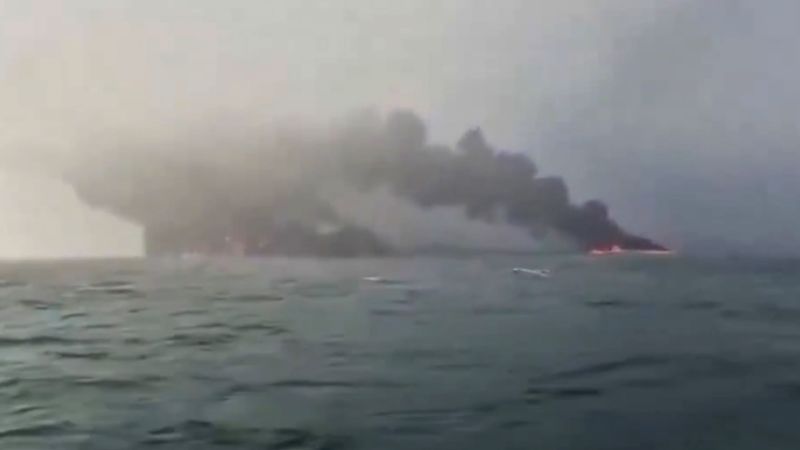London
CNN
—
A cargo ship that smashed into a US military chartered oil tanker off the northeast coast of England on Monday was carrying sodium cyanide, according to the maritime intelligence company and shipping journal Lloyd’s List.
The collision sparked a huge fire, a dramatic rescue effort and fears of environmental damage.
Just before 10 a.m. local time (6 a.m. ET), a Portuguese-flagged container ship called the Solong careered into the oil tanker, called the Stena Immaculate, which was at anchor in the North Sea about 10 miles off the English coastline, according to the ship tracking tool VesselFinder.
All but one of the Solong’s crew members have been brought safely to shore, the vessel’s owner Ernst Russ said in a statement, according to Reuters. Efforts to locate the missing crew member are ongoing, it added.
Crowley, a US logistics firm that manages the Stena Immaculate, confirmed that all members of its crew were safe. A total of 36 patients were treated by ambulance services after reaching the shore, according to Alastair Smith, Head of Operations for Lincolnshire at East Midlands Ambulance Service NHS Trust.
The Solong was carrying “an unknown quantity of alcohol and 15 containers of sodium cyanide,” Lloyd’s List reported. It is unclear whether the cyanide has entered the water.
Sodium cyanide, according to the US’ National Institute for Occupational Safety and Health, releases a highly toxic hydrogen cyanide gas that interferes with the body’s ability to use oxygen.
According to the US Department of Agriculture (USDA), sodium cyanide can also turn into hydrogen cyanide on contact with water.
Videos of the incident showed black plumes of smoke billowing into the sky and at least one of the vessels engulfed by flames.
The Stena Immaculate was carrying military jet fuel and marine diesel on its way to Killingholme, England, according to a spokesperson for the Defense Logistics Agency (DLA), an agency of the US’ Department of Defense.
The tanker was on a long-term charter with DLA Energy, which manages and distributes petroleum and fuel products. It was scheduled to re-supply fuel to Killingholme before reloading and delivering fuel to locations in the Mediterranean, the spokesperson said.
Crowley said there were “multiple explosions on board” after it was struck by the Solong.
The Solong left the Scottish port of Grangemouth on Sunday evening and was headed for Rotterdam, the Netherlands, at the time of the collision, according to VesselFinder.
Martyn Boyers, chief executive of the nearby Port of Grimsby East, told CNN earlier Monday that he had seen 32 people being brought ashore and that ambulances had been waiting to receive them.
It was not immediately clear how or why the collision occurred.
“It seems a mystery, really, because all the vessels now have very highly sophisticated technical equipment to plot courses and to look at any obstacles or anything they’ve got to avoid,” Boyers said.
“It’s difficult to actually suggest what went on, other than the fact it should never have happened,” he added.
The port chief said the Marine Accident Investigation Branch (MAIB) and the Marine and Coastguard Agency (MCA) would likely investigate what went wrong.
“How did that vessel continue plowing into the berth vessel? There must have been some warning signs. They must have been able to detect it on the radar,” Boyers said to CNN.
Crowley said in a statement that the Stena Immaculate had “sustained a ruptured cargo tank containing Jet-A1 fuel” due to the collision. It had anchored off the English coast after leaving the Greek port of Agioi Theodoroi last month, according to VesselFinder.
A flurry of high-speed ships and tugboats were seen moving toward the site of the collision at the time of the coastguard’s rescue operation, real-time data from VesselFinder showed.
Greenpeace UK said the “high speed of the collision and the footage of the aftermath are cause for great concern,” but stressed it is “too early to assess the extent of any environmental damage.”
A spokesperson said its potential impact relies on a number of factors, including the amount and type of oil carried by the tanker.
“In the case of an oil spill or any loss of hazardous cargo from the container ship involved, the speed of the response will also be crucial in limiting any impact,” the spokesperson said.
Experts say jet fuel spills tend to impact the environment less than crude oil spills. Bacteria can degrade the jet fuel molecules more quickly, leading to faster biodegradation, Mark Sephton, Professor of Organic Geochemistry at Imperial College London said.
“Whilst the images look worrying, from the perspective of the impact to the aquatic environment it’s less of a concern than if this had been crude oil because most of the jet fuel will evaporate very quickly,” Dr Mark Hartl, a marine ecotoxicologist from the Centre for Marine Biodiversity & Biotechnology at Heriot-Watt University added.
